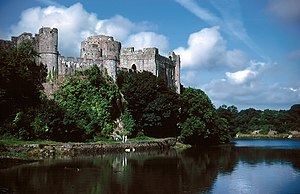Siege of Pembroke
| Siege of Pembroke | |||||||
|---|---|---|---|---|---|---|---|
| Part of the Second English Civil War | |||||||
 The north west side of Pembroke Castle |
|||||||
|
|||||||
| Belligerents | |||||||
| Royalists | Parliamentarians | ||||||
| Commanders and leaders | |||||||
| Major-General Rowland Laugharne Colonel Rice Powell |
Oliver Cromwell | ||||||
The Siege of Pembroke took place in 1648 during the Second English Civil War.
In April 1648, Parliamentarian troops in Wales, who had not been paid for a long time, staged a Royalist rebellion under the command of the Colonel John Poyer, the Parliamentarian Governor of Pembroke Castle. He was joined by Major-General Rowland Laugharne, his district commander, and Colonel Rice Powell. After the failure of his pre-emptive strike against the small Parliamentarian army of Colonel Thomas Horton at the Battle of St. Fagans, Laugharne retreated with what was left of his army to join Colonel Poyer at Pembroke.
Colonel Horton marched his 3,000 well disciplined troops, about half of which were dragoons, west to Tenby and laid siege to Tenby Castle which was held by about 500 Royalists under the command of Colonel Rice Powell. Oliver Cromwell with another Parliamentarian army consisting of three regiments of foot and two of horse had reached Gloucester on the day that the Royalist army was routed at the Battle of St. Fagans and proceeded to cross the south Welsh border shortly afterwards. He left Colonel Isaac Ewer in command of a small force to besiege the Royalist garrison of Chepstow Castle which was under the command of Sir Nicholas Kemeys and pressed on to join Horton at Tenby arriving on 15 May. Leaving Horton with enough men to deal with Powel, Cromwell marched the rest of the army to lay siege to Pembroke.
Kemeys was killed when Chepstow Castle was stormed on 25 May, and Powel was taken prisoner when he surrendered Tenby Castle to Horton on 31 May, but Pembroke Castle was a very strong medieval fortress which could not be taken as quickly. It stood on a rocky promontory surrounded on three sides by the sea, and on the landward side its defences consisted of a deep ditch and walls up to 20 feet (6.1 m) thick.
...
Wikipedia
